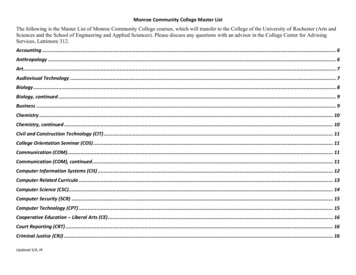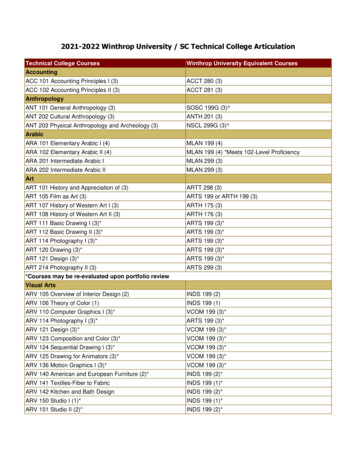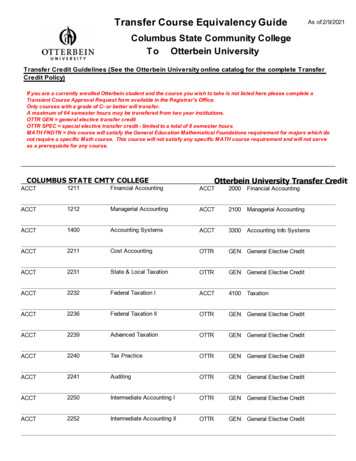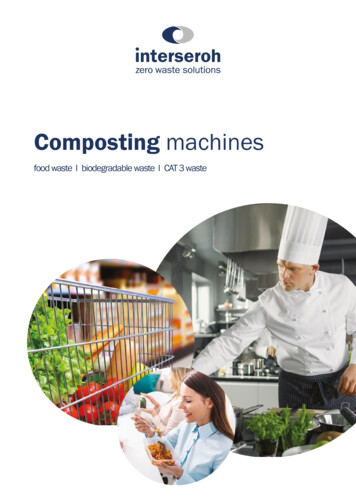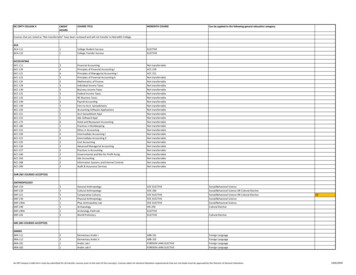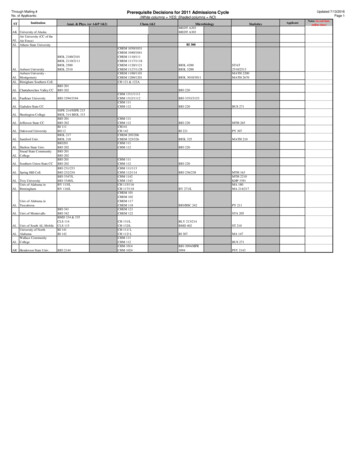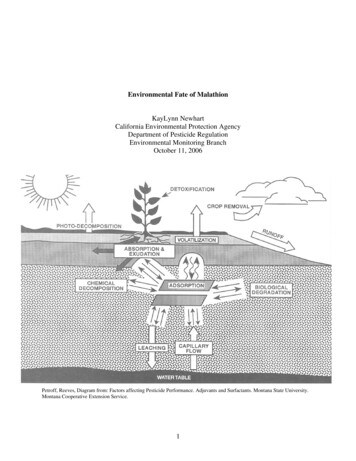
Transcription
Environmental Fate of MalathionKayLynn NewhartCalifornia Environmental Protection AgencyDepartment of Pesticide RegulationEnvironmental Monitoring BranchOctober 11, 2006Petroff, Reeves, Diagram from: Factors affecting Pesticide Performance. Adjuvants and Surfactants. Montana State University.Montana Cooperative Extension Service.1
IntroductionMalathion is an organophosphorus insecticide used in public health, residential, and agriculturalsettings as early as 1950. Over 100 food crops can be treated with malathion, and about half oftotal applications in the United States (U.S.) are on alfalfa, cotton, rice, sorghum, and wheat.Annual use of malathion is over 16.7 million lbs active ingredient (ai) per year of whichapproximately 12.5 million lbs ai is used on food crops alone (ATSDR, 2003). The followinguses constitute 4.2 million lbs ai per year with application to stored commodities, empty storagefacilities, home and garden, golf courses, mosquito abatement, ornamental nursery stock andturf, Christmas tree plantations, parks, cemeteries, garbage areas, irrigation systems, outdoordwellings (domestic and commercial), intermittently flooded areas, sewage systems, pastures,and rangeland (ATSDR, 2003). Malathion has been used in three major regional eradicationprograms in the U.S., specifically Boll Weevil eradication on cotton (11.2 million lbs/year),Medfly control (800,000 lbs/year), and mosquito control (472,000 lbs/year). A non-FIFRApharmaceutical use of malathion is as a pediculicide for head lice and ova (U.S.EPA, 2000). In2004, the Department of Pesticide Regulation (DPR) reported that 492,307 pounds of malathionwere used in California (California Department of Pesticide Regulation’s Pesticide UseDatabase. 2004).There are 38 basic producers of malathion and it is used in approximately 1,953 productsworldwide (MeisterPro, 2003). Of those approximately 174 products are registered for use in theU.S. of which 36 products are currently registered for use in California (NPIRS, 2004).Malathion is formulated as an emulsifiable concentrate (EC), a dust (D), a wettable powder(WP), a pressurized liquid (PrL), and as ready-to-use liquids used for ultra-low-volume (ULV)application. Examples of common product names include Agrisect, Atrapa, Bonide, Prentox,Clean Crop malathion, Acme malathion, Black Leaf malathion spray, Eliminator, Fyfanon, andGowan malathion dust.Malathion has a broad range of use with target pests in the orders dipterans, lepidoptera,hemiptera, coleoptera, and other orders. Malathion is a slightly toxic compound in EPA toxicityclass III and labels for malathion products must carry the signal word “CAUTION”.Malaoxon is an oxygen analogue of malathion and it can be found either as an impurity inmalathion product, or can be generated during the oxidation of malathion in air or soil. Malaoxonis the active cholinesterase inhibiting metabolite of malathion. Both malathion and malaoxon aredetoxified by carboxyesterases to polar, water-soluble compounds that are excreted.2
Chemical Structure of MalathionOOCH3OCH3SH3C O PH3C OSOChemical Structure of MalaoxonOOCH3OCH3OH3C OH3C OPSO3
Degradation Pathway of MalathionPhysical Characteristics of MalathionComposition: Diethyl (dimethoxythiophosphorylthio)succinateProperties: Clear to amber liquid with a mercaptan odor.Henry’s Law Constant: 4.89X10-9 atm/m3 molSpecific Gravity: 1.23 at 25 CMelting Point: 2.85 CMolecular Weight: 330.36Water Solubility: 130 mg/LPartition Coefficient: 2.7482Adsorption Coefficient: 1,800Vapor Pressure: 3.38X10-6mm Hg at 30 CMiscible in most organic solvents; limited solubility in aliphatic hydrocarbon.4
Environmental FateAirMalathion and malaoxon can be transported in air by drift from applications to non-target sites.Movement in air can also occur due to volatilization, fog, and wind. Residues in small dropletsproduced by ultra low volume (ULV) aerial applications have been shown to drift for longdistances, causing adverse effects in surrounding waterways (Lenoir, 1999). Concentrations ofmalathion have been measured at levels high enough to cause mortality for non-targetinvertebrates as far as 200 meters from the application site (USEPA, 2000). There are currentlyno aerial buffers on malathion labels to mitigate potential for offsite movement (ATSDR, 2003).In 1990, the California Department of Food and Agriculture monitored air samples for malathionand malaoxon during Mexican fruit fly eradication in San Diego County (Turner et al. 1991). Anarea-designated habitat of an endangered species (Least Bell’s Vireo) just outside of thesoutheastern boundary of the treatment area was monitored for malathion deposition duringapplications. Concentrations detected were 16.97 µg/ft2 during the first application and 24.02µg/ft2 during the last application. The study concluded that drift was the likely cause of thesedetections.The California Department of Food and Agriculture monitored malathion and malaoxon duringthe eradication of Mediterranean fruit flies in Southern California in 1990 (Segawa et al. 1991).Several sites were “flagged” to be intentionally avoided by aircraft applying malathion baitspray. The concentration at these sites ranged from 1.0 µg/m2 to 101 µg/m2. The study concludedthat 92% of the total of malathion applied was accounted for on the ground surface of thetargeted spray areas. The 8% of malathion unaccounted for either degraded before hitting theground, volatilized before sample collection, or drifted outside of the target area.Environmental sampling was conducted in Ventura County, California during the MediterraneanFruit Fly Eradication Program from 1994-1995 (Sanders, 1994). Deposition of malathionaveraged 8.21 mg/m2. Malaoxon was not detected in 25 percent of the samples with the highestmalaoxon concentration at 0.07 mg/m2. Malathion air concentration averaged 0.004 ug/m3 duringthe pre-spray interval and then was elevated to 0.067 ug/m3 during application. Airconcentrations remained elevated measuring 0.049 ug/m3 during the 24 hours immediatelyfollowing application and at 0.042 ug/m3 for the interval 24-48 hours after application. Malaoxonwas detected at an average concentration of 0.010 ug/m3 during both the first postspray andsecond postspray sampling intervals. The highest concentration in air was 0.176 ug/m3.The Florida Department of Environmental Protection (FDEP, 1998) conducted a drift studyassessing the biological effect of malathion following ULV applications made for MediterraneanFruit Fly eradication. Biological assessment was conducted for five lakes in Umatilla, Florida inthe shallow (littoral zone) areas of each lake. The macroinvertebrate community measured in thelakes consisted of a number of water mites (Ephemeroptera, Acariformes, Hydrodroma),caddisflies (Trichoptera), mayflies (Ephemeroptera), midges (Polypeilum halterale), freshwaterworms (Oligochaete), and flatworms (Turbellarians). Samples collected post application showeda reduction or total absence of Turbellarians and of Oligochaetes in lake sediments as well as5
other organisms. In four lakes there were declines of total numbers of organisms and diversityindex declines in three lakes. Malathion water column concentrations ranged from 0.3 to 4.5 ug/l.Recommendations from the results of the study supported preserving a 100 foot buffer aroundwaterbodies when malathion was applied by air. It was also suggested while malathion can effectorganisms in the water column, that monitoring for measurable effects to sediment dwellingorganisms should also be done when using malathion for future Medfly eradication.Volatilization of malathion was also reported in a study conducted in agricultural conditions inthe Bologna province, Italy (Ferari et al., 2003). Air concentrations of malathion were monitored2-3 weeks after pesticide applications to a bare, silty-textured soil. The authors estimatedmalathion volatilization at 1.3 mg/m2 during the day and 0.9 mg/m2 during the night. The studyconcluded that for pesticides with vapor pressures between 5 x 10-3 and 5 x 10-2 volatilizationcan represent up to 22.6% of the total fate in the environment. Consequently, volatilization mayresult in significant exposures in air and may impact the air quality of the area surrounding theagricultural field.Other studies have also indicated transport of malathion over large distances. In California,LeNoir et al. (1999) reported that malathion applied in lower elevations of California volatilizeunder high temperatures in summer and was transported to higher elevations of the SierraNevada mountain range. The authors measured high volume air, dry deposition, and surfacewater samples in the Central Valley and at various elevations in Sequoia National Park.Malathion and other pesticides were measured in high volume air, dry deposition, and surfacewater samples collected a various elevations in Sequoia National Park to determine atmospherictransport of pesticides. Detailed pesticide use was collected in Fresno and Tulare countiesimmediately downwind of the park’s entrance. Although malathion usage was not significant atany time, it has widespread home, garden and mosquito abatement uses. Malathion use rangedfrom zero kg a.i. up to 2,280 kg a.i./month from January through December 1995 in FresnoCounty. Tulare County use ranged from 2 kg a.i. up to 4,456 kg a.i./month for the same timeperiod. At Kaweah Reservoir at 200 m air samples resulted in two detections of 0.29 and0.40 ng/m3 in May and June. At Ash Mountain air samples collected at 533 m had a singledetection of malathion on May 30 of 0.15 ng/m3. In surface water samples collected at elevationsfrom 118 m up to 3,322 m malathion was detected in six locations ranging from 64.97 ng/L up to83.0 ng/L.In a study of the Chesapeake Bay on the east coast malathion was present in 30% of air samplesand 50% of rain samples collected in Spring and Summer 1995 with maximum wet depositionflux measurement for malathion at 1.8 ug/m2 –d (Harman-Fetcho et al., 2000). On the east coastof central Florida, malathion was found to drift on to shoreline beaches and surface water nearcoastal marshes due to ULV applications for mosquito control (Clark et al.1993). In addition, astudy conducted in the Florida Keys (Hennessey et al., 1992) found aerial thermal fog drifted750 m into protected no-spray zones of endangered species habitat.WaterDegradation of malathion in water is pH dependant and degrades quickly in water with pH 7.0.Malathion does not accumulate in sediment but can be present in sediment following application.6
Hydrolysis is the main route of degradation in alkaline aerobic conditions. The half-life range ofmalathion is 0.2 weeks at pH 8.0 compared to 21 weeks at pH 6.0. Metabolites resulting fromhydrolysis include malaoxon, malathion alpha and beta monoacid, diethyl fumarate, diethylthiomalate, O,O-dimethylphosphorodithioic acid, diethylthiomalate, andO,O-dimethylphosphorothionic acid.Biodegradation also plays a role when pH 7.0 and the rate of hydrolysis is slow relative to therate of biodegradation. Breakdown constituents of biodegration include beta monocaboxylic aciddicarboxylic acid, and diethyl thiomalate. Malathion is not persistant under anaerobic conditions.However, malaoxon has higher solubility and the potential for runoff is greater.Detections of Malathion and Malaoxon in WaterAerial application of malathion bait mixture to eradicate the Mediterranean fruit fly in Californiaprompted a study of the levels of malathion and malaoxon in water. Segawa, et al., (1990) foundan average of 49.4 ug/L malathion in freshwater ponds and 9.38 ug/L in swimming poolssampled immediately after application. The average level of malaoxon was 0.80 ug/L in theponds and 16.5 ug/L in the swimming pools. In addition water runoff was sampled from tworivers, two runoff channels, and a marsh in areas where drainage could be impacted by malathionapplications. Concentrations exceeded 3.54 ug/L malathion (24-hour exposure) on three of eightsampling dates. The authors concluded that the most likely occurrence of an environmentalimpact from high concentrations of malathion would be from winter applications when rainfall isthe heaviest.Water samples were also taken in subsequent Mediterranean fruit fly eradication spraying. In1994, during a six-week period in Riverside, California (Ando et al. 1994) monitored malathionand malaoxon detections in water throughout the application period. Concentrations of malathionin rain runoff to storm drains were measured as high as 583 ug/L. Additionally, malathion andmalaoxon were analyzed in water samples obtained during the 1994-1995 Mediterranean FruitFly Eradication Program in Ventura County in samples following applications malathionconcentrations averaged 44.2 ug/L (ranging from 39.1 to 50.3 ug/L) and malaoxon concentrationaveraged 0.05 ug/L. In rain runoff samples the highest malathion concentration of 787.1 ug/Loccurred 3 days following application in Calleguas Creek. The highest malaoxon concentrationwas 160.2 ug/L at the same location 12 days following application. Malathion and malaoxonwere also detected at Calleguas Creek, a freshwater channel that enters Mugu Lagoon is locatedwithin Naval Weapons Station, Point Mugu in Southern Ventura County. It provides one of thelargest undeveloped coastal wetlands and contains protected riparian areas and has importantrecreation uses as well. Detections of malathion were reported at 11.1 ug/L and 2.62 ug/L. Thestudy results showed that concentrations were potentially toxic to aquatic life, although no fishkills were reported.Storm water runoff from urban areas was found to have higher levels of malathion thanagricultural settings in a study conducted by USGS as part of the National Water QualityAssessment Program in the Tuolumne River Basin in Modesto, California (Kratzer, 1998).Stormwater runoff samples from agricultural and urban areas were analyzed for pesticides duringa February 8-10 storm event for agricultural areas and for urban sites February 13-14 in 1995.7
Malathion detections ranged from 0.038 mg/L up to 0.068 mg/L from five storm drains inModesto, California. In agricultural runoff samples malathion was detected 10 times at less than0.005 and up to .096 ug/L at two other urban runoff sites. All of the urban runoff samplesexceeded the National Academy of Engineering guidelines for chronic criteria for the protectionof freshwater aquatic life for malathion (0.1-0.008 mg/L). Less degradation from soil occurswhere malathion lands on urban hard surfaces, resulting in more material moving off targetedapplication areas in rain runoff (USGS, 2000).GroundwaterMalathion is moderately to highly mobile in soil and has been detected in groundwater in onewell in California (0.32 ug/L), two wells in Mississippi (0.03-0.053 ug/L), and nine wells inVirginia (range 0.007-6.17 ug/L). Generally, degradation occurs rapidly and groundwatercontamination has not been found to be widespread. EFED concluded that there is potential formovement of malathion to groundwater especially in soils with low organic matter and high sandcontent. Also, since the normal site of application of malathion is to foliage, application tofoliage is potentially a factor that mitigates movement to ground water. In California, pesticideshave been determined to move to ground water as a result of non-point source applications ofsoil-applied pesticides (Schuette et al., 2005). Application to foliage allows for exposure ofresidues to degradation from processes such as photolysis, resulting in a reduced potential forsignificant movement to ground water.Surface WaterDPR has been collecting data for pesticide sampling in a Surface Water tm). The database contains 7,000 sampling recordsfor malathion sampled between August 1990-June 2005. Of those samples, 306 containedmalathion at concentrations ranging from .005 ug/L to 6.0 ug/L.Malathion was also reported in samples collected for the NAWQA program conducted by USGS.That study provides a nationwide study of pesticides in surface and ground water. Table 1contains a summary of malathion detections in samples USGS collected during the study for1992 to 1996. These results indicated that urban streams had the most detections(19.57 % of 327 total samples) followed by large streams and rivers (8.16% of 245 totalsamples). The highest concentrations were found in urban streams with 17.13% of samplesgreater than 0.1 ug/L and 7.03 greater than 0.05 ug/L. The least amount of detections were inmajor aquifers, shallow groundwater agricultural areas and no detections in shallow groundwaterurban areas. This implies that urban use of malathion could be a major contributor to off-sitemovement of malathion to adjacent urban waterways.8
Table 1. Malathion detections in ground and surface water fromUSGS-NAWQA program (1992-1996).Surface Water% Samples% Samples% SamplesSites SampledTotal SamplesMalathion 0.01 ug/L 0.05 ug/LDetected1,0585,1967.455.511.81Agricultural Stream Sites4011149339249241,0005.603.70Urban Streams32719.5717.13Integrator Sites (large streams and rivers)2458.166.12MajorAquifersnot reported0.430.11Shallow Groundwater-Agricultural Areas9240.320.11Shallow Groundwater Urban Areas301NDND0.507.031.22ND0.11NDTerrestrial FateThe primary route of malathion degradation in soil is through aerobic soil metabolism. The halflife of malathion in soil was reported to be 3 days in alkaline soil and 7 days in acidic soil.Biodegradation by microorganisms is an important fate process in soil. This is especially truewhen pH 7.0. Malathion mono and dicarboxylic acids, malaoxon, ethyl hydrogen fumarate,diethyl thiosuccinate, and CO2 are degradates that have been identified in laboratory and fieldstudies. The major metabolite in soil is malathion beta monoacid and has a reported half-life of4-6 days (Paschal et al., 1976).A study of malathion persistence in water, sand, soil, and plant matrices showed that malathiondegrades to malaoxon less quickly in soils with greater amounts of organic matter affectingpesticide fixation in soils (Neal et al. 1993). The study supported this because since more rapiddegradation occurred in sandy soil lacking an organic fraction. It was found for soil that the timeit took for reduction to 50% of the initial concentration was less than 12 hours. The sand matrixshowed this reduction to be 20% in less than 12 hours. Pashal and Neville (1976) suggested thatmalaoxon persistence was more likely in loamy soil. The rate of hydrolysis was reported at50-90% in 24 hours.Effects on Aquatic SpeciesAquatic organisms are affected at environmental concentrations less than 100 ug/L.Concentrations at these levels have been routinely detected at presently recommendedapplication rates in adjacent tributaries and retention ponds near urban areas. USGS dataindicated higher levels of malathion and more detections in urban streams than were monitored9
in rural and agricultural areas (USGS NAWQUA, 2000). In 96-hour toxicity studies, the LC50values for fish ranged from 4-11,700 ug/L and 0.5-3,000 ug/L for aquatic invertebrates.Malathion detections have been more common and at higher levels in urban surface water areas.Risks to aquatic species become greater when repeated applications occur, resulting in continualexposure to peak concentrations. Malathion has a high potential to drift from ultra-low volume(ULV) applications and impact aquatic habitat. Toxicity to fish species (Table 2) varies fromvery highly toxic ( 0.1 ug/l) to practically non-toxic ( 100 ug/l).Table 2. Relative toxicities to various fish and species exposed to malathion.Toxicity LC50Species(96-hour) (ug/L)Walleye (Stizostedion vitreum)0.06Brown trout (Salmo trutta)0.1Cutthroat trout (Salmo clarki)0.28Rainbow trout (Oncorhynchus mykiss)4.0Fathead minnow (Pimephales promelas)8.6Sheepshead minnow (Cyprinodon variegatus)33.0Western Mosquitofish (Gambusia affinis)50.0Goldfish (Carassius auratus)10.7Bluegill sunfish (Lepomis macrochirus)20.0Largemouth bass (Micropterus salminoides)250Channel catfish (Ictalurus punctatus)7,620Coho salmon (Oncorhynchus kisutch)170Striped bass (Marone saxatilis)60.0U.S. EPA defines a Risk Quotient (RQ) as the ratio of the estimated environmental concentrationof a chemical to a toxicity test effect level for a given species. To estimate potential ecologicalrisk, EPA integrates the results of exposure and ecotoxicity using the quotient method. Riskquotients (RQs) are calculated by dividing exposure estimates by ecotoxicity values, both acuteand chronic, for various wildlife species. RQs are then compared to levels of concern (LOCs).Generally, the higher the RQ, the greater the potential risk. Risk characterization provides furtherinformation on the likelihood of adverse effect occurring by considering the fate of the chemicalin the environment, communities and species potentially at risk, their spatial and temporaldistributions, and the nature of the effects observed in studies (U.S.EPA, 1999).The U.S. EPA RQ acute criteria for malathion of aquatic invertebrates ranges from 8.2-226 ug/L.The chronic RQ ranges from 33-931 ug/L for invertebrates and is 0.04-1.0 ug/L for fish. Theacute RQ for fish species ranges from 0.3-7.4 ug/L.The Bureau of Sport Fisheries and Wildlife in 1969 observed synergism in bluegill and rainbowtrout when malathion was mixed with Baytex, EPN, parathion, perthane, and carbaryl. Additiveeffects were also noted from combinations with DDT and toxaphene. Chronic effects on growthof Flagfish (Jordanella floridae) have been observed from mixtures of endrin and malathion(Hermanutz et al. 1985).10
A number of growth anomalies have also been observed when fish were exposed to malathionand malaoxon. Although malathion caused no mortality of Clarias gariepinus (African catfish)embryos at 5.0 mg/L, the LOEC value of 10 mg/L was found for Zebra fish (D. rerio). There wasalso no effect on hatching of C. gariepinus observed up to the highest concentraion of malathiontested, but the hatching of D. rerio was inhibited at 3.0 mg/L. Reduced survival of C. gariepinuslarvae was observed at 20.0 mg/L and for D. rerio larvae the value of 43 mg/L caused reducedsurvival. The study results also included observations of abnormal body axis development in C.gariepinus, and pericardial edema in D. rerio exposed to 1.25 mg/L and 3.0 mg/L malathion(Nguyen et al., 2001). Oncorhynchus mykiss (rainbow trout) exposed to concentrations up to 40ug/L caused significant changes in swimming behaviors due to inhibition of cholinesterase(Beauvais et al. 2000).There have been reports of gill malfunctions and respiratory distress in bluegills as an earlysymptom of malathion exposure due to the loss of adhesion between epithelial cells and theunderlying pillar cell system, resulting in the collapse of the lamellae structural integrity(Richmonds et al., 1989).In other studies, an LOEC value of 1.0 mg/L was obtained in the 32-day Early Life Stage testwith D. rerio. When killifish (Fundulus heteroclitus) were exposed to malathion for 55 days at aconcentration of 10 mg/L, abnormal axis formation in the embryos was observed at thisconcentration (Crawford et al. 1985).The California Department of Fish and Game (DFG) conducted a hazard assessment of theinsecticide malathion to aquatic organisms in the Sacramento and San Joaquin rivers in 1998.The most acutely sensitive freshwater species was found to be the stonefly (Isoperia sp.) with aGenus Mean Acute Value (GMAV) of 0.69 ug/L malathion. The most acutely sensitive saltwaterspecies was the mysid (Mysidopsis bahia) with a GMAV of 5.20 ug/L. The lowest MaximumAcceptable toxicant Concentration (MATC) for bluegill (Lepomis macrochirus) was 5.16 ug/L.The Final Chronic Values (FAV) for malathion were found to be 0.86 ug/L for freshwater andthe interim saltwater FAV was 0.67 ug/L. DFG found that freshwater organisms should not beaffected if the one hour concentration of malathion does not exceed the Criterion MaximumConcentration (CMC) of 0.43 ug/L. The CMC level of malathion was exceeded seven times inthe Sacramento Valley rice growing areas from April 1990 to June 1996. In the San JoaquinRiver system the maximum concentration of malathion was 0.28 ug/L in 1992.The United States Fish and Wildlife Service (USFWS. 1969) concluded that malathion isclassified as highly to very highly toxic to aquatic early life stages of non-target insects(Table 3).11
Table 3. Toxicity to Aquatic Larvae of Terrestrial Insects.SpeciesLC50 (ppb)Stonefly (Claasenia sabulosa)2.8Stonefly (Pteronarcella badia)1.1Stonefly (Isoperla sp.)0.69Damselfly (Lestes congener)10.0Caddisfly (Hydropsyche sp.)5.0Caddisfly (Limnephalus sp.)1.3Snipefly (Atherix variegata)385USFWS results for acute toxicity to freshwater and marine and estuarine invertebrates areincluded in Table 4.Table 4. Acute toxicity (LC50) values for freshwater andmarine (estaurine) invertebrates.SpeciesEC50 or LC50 (ppb)Water flea (Daphnia pulex)1.8 (48 hr EC50)Scud (Gammarus lacustris)1.8 (48 hr LC50)Scud (Gammarus fasciatus)0.5 (96 hr LC50)Daphnid (Simocephalus0.69 (48 hr LC50)serrulatus)Crayfish (Orconectes nais)180 (96 hr LC50)Glass shrimp (Palaemonetes12.0 (96 hr LC50)kadiakensis)Seed shrimp (Cypridopsis vidua)47 (49 hr LC50)Water flea (Daphnia magna)1.0 (48 hr EC50)Sowbug (Asellus brevicaudus)3,000 (96 hr LC50)Mysid (Mysidopsis bahia)2.2 (96 hr LC50)Pink shrimp (Penaeus duorarum)280 (48 hr LC50)Eastern oyster2,960 (96 hr EC50)(Crassostrea virginica)Blue crab (Callinectes sapidus)1,000 (48 hr LC50)Biota Effects of MalathionAmphibiansBullfrogs (Rana catesbeiana) were exposed to malathion in water in a 28-day static renewal test(Fordham et al., 2000). Survival was decreased at the level of 2,500 ug/L and higher.Development of tadpoles was significantly delayed by malathion exposure as well. The studysuggests that malathion may decrease thyroid function in tadpoles. Equilibrium posture was alsofound to be impaired in tadpoles from all of the treatment groups (500 to 3,000 ug/L). This canbe detrimental to survivability due to predation loss and decreased feeding. Based on the studyresults it appears unlikely that overt mortality would occur since the exposure was higher thanwhat is documented in wetlands and streams currently.12
In another study (Taylor et al.1999), adult male Woodhouse’s toads (Bufo woodhousi) died at ahigher rate and developed disease when exposed externally to either a high or low sublethal dose(0.011 or 0.0011 mg malathion/gram toad). The study concluded that Woodhouse’s toadsexposed to field grade malathion were more susceptible to disease.Notochordal effects and bent spines were observed in Xenopus (frogs) as well as a generalretardation in growth and development and vascular abnormalities (Snawder and Chambers,1989, 1990, 1993).AvianMalathion is potentially hazardous to avian species at application rates above 2.5 lbs ai/acre(U.S.EPA. 2000). Many malathion labels list application rates greater than 6.25 lbs ai/acre.Concerns exist regarding long term exposure to repeated high residues and subsequent chroniceffects on reproduction of exposure to nests and juvenile birds. Sublethal effects to birds fromacetylcholinesterase inhibition may include reduced nesting behavior, disorientation, and loss ofmotor coordination leading to reduced ability to cope with the daily stresses of survival undernatural conditions. There have been observations of abnormal feathering and beak deformationin birds exposed to malathion and malaoxon. U.S.EPA concluded as part of a revised riskassessment of malathion that chronic exposure to birds is of concern because consecutiveapplications at peak use rates are not restricted. While malathion is non-persistant in theenvironment, repeated exposures can occur up to 14 days that subject birds to repeat doses. Thisis of greater concern when birds are nesting. Risk quotients (RQ) for dietary risk to avian speciesexposed to malathion are 0.001-0.72 mg/kg (acute) and 0.01-18.1 mg/kg (chronic).The reported acute oral LD50 values for various bird species are: mallards, 1,485 mg/kg;pheasants, 167 mg/kg; blackbirds and starlings, over 100 mg/kg; and chickens, 525 mg/kg. The5- to 8-day dietary LC50 is greater than 3,000 ppm in Japanese quail, mallard, and northernbobwhite quail, and is at 2,639 ppm in ring-necked pheasants. About 90% of malathion isthought to be metabolized and excreted in urine 24 hours after birds ingest it.In a study in Ohio, (Giles et al.1970), a 20-acre watershed was treated with malathion radioisotope tagged with sulfur 35. The application rate was 2 lbs a.i./acre with 4 successivemalathion treatments. Birds showed adverse reaction up to 48 hours post application. Lack ofbirds singing was observed for 2 days. By day 4 singing intensity was the same as the controlarea. The study suggests sublethal insecticidal effects possibly due to reduction in food source orbird emigration from treated areas. Raiodioactivity was detected in collected bird’s whole organtissues. Insectivorous birds had high radioactivity on their feathers.Enhanced toxicity effects in birds have been observed when propicoanzole, vincloxolin, andclomitrimazole are used with malathion (Martin et al. 1995). In addition, Japanese quail, redlegged partridge, and pigeons showed increased toxicity to malathion when exposed at the sametime to the fungicide prochloraz (Riviere et al.1985).13
Mammals and ReptilesSublethal effects occur to mammals and reptiles due to their susceptibility to the inhibition ofacetylcholinestease. U.S.EPA has concluded that small mammals are at risk when exposed to thehighest application rates of malathion (U.S. EPA. 2000). The exposure RQs for small mammalsare 0.10-3.65 ug/L for acute and 0.005-3.0 ug/L chronic effects. In the Ohio study, white footedmice (Peromyscus leucopus novaboracensis) population was
Medfly control (800,000 lbs/year), and mosquito control (472,000 lbs/year). A non-FIFRA pharmaceutical use of malathion is as a pediculicide for head lice and ova (U.S.EPA, 2000). In 2004, the Department of Pesticide Regulation (DPR) reported that 492,307 pounds of malathion
